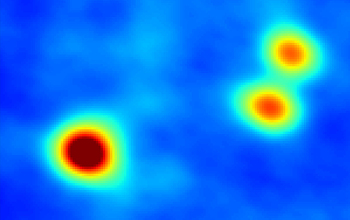Multimedia Gallery
Young triple-star system in Perseus molecular cloud
A young triple-star system in the Perseus molecular cloud, imaged with the Very Large Array.
More about this image
A detailed study of young stars and their surroundings has produced dramatic new evidence about how multiple-star systems form and how the dusty disks that are the raw material for planets grow around young stars. Teams of scientists used the National Science Foundation’s Karl G. Jansky Very Large Array radio telescope to study nearly 100 newborn stars in a cloud of gas and dust about 750 light-years from Earth, in which new stars are forming.
Images made from the study showed unprecedented detail of a number of the young stars, and are helping astronomers resolve important questions about how stars, binary stars and planets get their beginning.
One research team concluded that two different formation mechanisms may be at work to produce young multiple-star systems. They noted that the systems they studied fell into two distinct types, based on the distance between the stars in the system. The closer systems have stars separated by about 75 times the sun-Earth distance, and another group has its stars separated by about 3,000 times the sun-Earth distance. They also found that more than half of the youngest stars they studied are in multiple systems, suggesting that star formation tends to produce multiples rather than single stars.
Another team found that the dusty disks around some of the protostars are larger than some theoretical models predict. These disks are essential to the formation of planets, some binary companions, and the young star’s ability to draw in additional material. Despite their central role in these processes, however, their formation mechanisms have been debated among astronomers.
[Research supported by the National Science Foundation (grant AST 0836064).]
Read more about this research in the NSF News From the Field story VLA reveals dramatic new evidence about star, planet formation. (Date image taken: unknown; date originally posted to NSF Multimedia Gallery: Jan. 2, 2018)
Credit: Segura-Cox, et al., NRAO/AUI/NSF
Images and other media in the National Science Foundation Multimedia Gallery are available for use in print and electronic material by NSF employees, members of the media, university staff, teachers and the general public. All media in the gallery are intended for personal, educational and nonprofit/non-commercial use only.
Images credited to the National Science Foundation, a federal agency, are in the public domain. The images were created by employees of the United States Government as part of their official duties or prepared by contractors as "works for hire" for NSF. You may freely use NSF-credited images and, at your discretion, credit NSF with a "Courtesy: National Science Foundation" notation.
Additional information about general usage can be found in Conditions.
Also Available:
Download the high-resolution JPG version of the image. (481.1 KB)
Use your mouse to right-click (Mac users may need to Ctrl-click) the link above and choose the option that will save the file or target to your computer.



 All images in this series
All images in this series